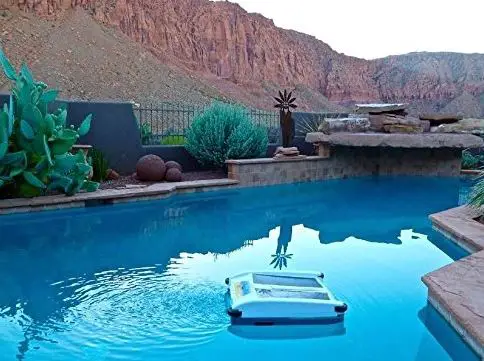
The Ultimate Guide To Automatic Pool Cleaners 2023
DISCLOSURE: As an Amazon Associate, I earn from qualifying purchases.
Scrubbing your pool, vacuuming it, balancing chemicals and all other maintenance tasks can be tedious and time-consuming. But they are essential in keeping your pool clean and safe to swim in.
However, you don’t have to give up your precious weekend time or spend a lot of money on a pool service to keep your pool clean.
Investing in a quality automatic pool cleaner makes pool maintenance easier and cheaper.
Automatic pool cleaners work on their own. They clean as well and sometimes even better than your pool guy.
If you are thinking about buying an automatic pool cleaner, this guide will help focus you on exactly what you need.
In it, we explain the three types of automatic pool cleaners –suction, pressure and robotic – and explain the costs and ins and outs of owning and maintaining them.
What’s In This Guide
Pool Water Circulation
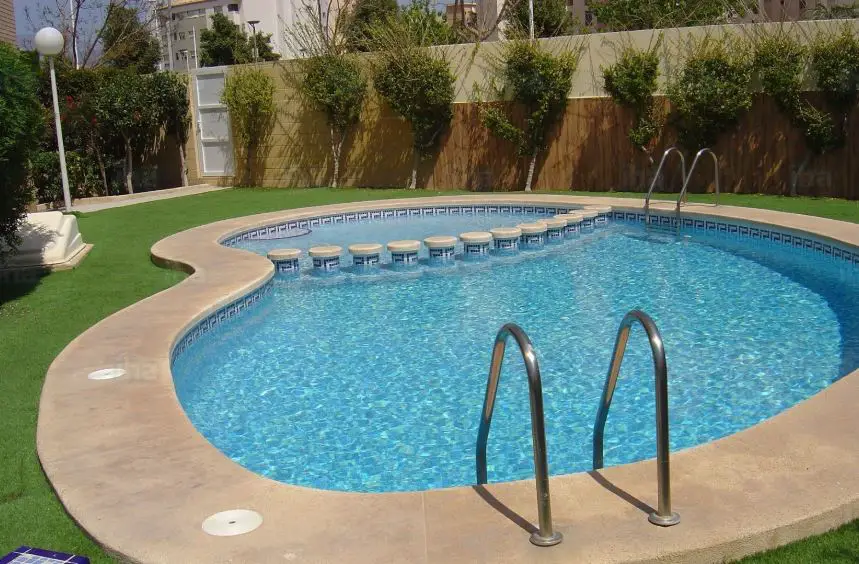
Before we explain how each type of automatic pool cleaner works, it’s important to understand the basics of pool water circulation.
To keep your pool healthy, it’s essential to keep the water moving. This ensures that dirt, microbes, and algae don’t build up in the pool.
Your pool pump does the job of circulating water in and out of the pool and passing it through the pool filter.
Water goes out through the suction side and returns through the pressure side.
The two most common types of automatic pool cleaners – suction side cleaners and pressure side cleaners – use this circulation system to clean your pool.
Robotic pool cleaners, on the other hand, don’t depend on the water’s circulation.
Let’s discuss each type in more detail.
Suction Side Pool Cleaners
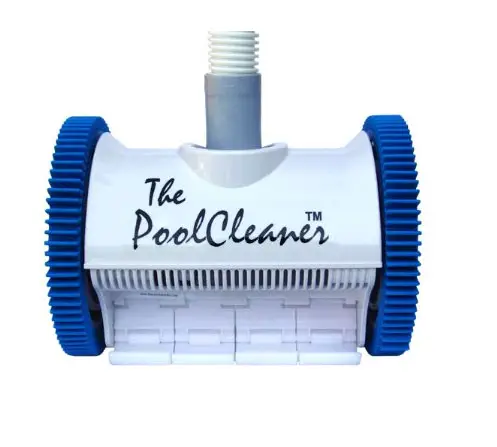
These are the simplest and cheapest automatic pool cleaners.
They are ideal for screened in-ground pools with few to no leaves or twigs in water that are mostly affected by dirt and sand.
A suction side pool cleaner connects to your pool skimmer or a dedicated suction line. The pressure of the water being sucked out of the pool moves the robot around in the pool.
The cleaner picks up small and medium-size debris and directs it through the suction line and the pool’s filter.
This can quickly overload your pool filter and pump especially when the pool is dirty. It’s important to keep checking whether the skimmer basket needs emptying.
Some suction side pool cleaners use wheel drives for easier mobility while others consist of a flat disk that ambles along on the pool floor.
Some cleaners use bristles to scrub algae and dirt that stick to the pool floor.
You’ll also find suction side cleaners that only clean the floor while others can do the floor and walls.
As for pricing, suction side pool cleaners range between $100 and $500, making them ideal for those on a tight budget.
How to Install a Suction Side Pool Cleaner
Suction pool cleaners are generally easy to install and are compatible with most pool systems.
Unlike some pressure side pool cleaners, you don’t need to install a booster pump.
Make sure you buy the right suction side pool cleaner for your pool. Specifically, check the manufacturer’s pump size recommendations.
Most suction side cleaners require a poop pump of at least 3/4 HP. If your pump is smaller than that, there won’t be enough pressure to move the pool cleaner.
Once you have the right cleaner, here’s how to install it:
Note: Read the manual before installing the pool cleaner.
- Turn off your pool pump.
- It’s important to start with a clean pool. Scrub the walls and floor and then vacuum your pool. Clean the filter and pump strainer basket. Also, check that your pool has the right chemical balance.
- Switch on the pool pump and let it run for around five minutes. This will clear the lines to ensure maximum suction pressure.
- Turn off the main drain line and all suction lines except the one you’ll connect the cleaner to.
- If the suction cleaner needs assembly, assemble it at this point. This includes the long hose that will run from the skimmer to the pool cleaner. Make sure the hose is not too long (it will get tangled) or too short (it will limit the cleaner’s reach). To get the right length, stretch the hose from the skimmer to the farthest wall and trim off the excess length.
- Remove the skimmer basket and complete the skimmer assembly. This includes attaching the compression adapter and the regulator valve. Check the manual for specific instructions on how to connect these fittings.
- Submerge the hose in the pool and let it fill with water. This eliminates all air from the hose to ensure maximum suction.
- Keeping the hose submerged, connect the skimmer end to the regulator valve.
- While still keeping the other end of the hose submerged, place the pool cleaner in water and wait for the bubbles to disappear. Then connect the hose to the cleaner.
- Let the cleaner sink to the bottom of the pool then turn on the pool pump. You should see the cleaner moving about in the pool. If it doesn’t seem to be moving or is too slow, check that the pump basket is clean and that you’ve turned the suction line valves to the right position.
Note: Some suction side cleaners need additional adjustment to the hose and weights to work properly. Consult your manual for setting up and troubleshooting advice.
Maintaining a Suction Side Pool Cleaner
To keep your suction cleaner working properly, empty the pump basket frequently.
Also, check the cleaner frequently to make sure each component is working properly. Debris trapped in the flapper, bristles or wheels can affect how the cleaner works.
You’ll also need to replace worn out parts regularly as recommended in the manual.
Most manufacturers recommend leaving the cleaner in the pool to constantly clean whenever the pool pump is on.
Only remove it when you are swimming or during chemical balancing.
If you’ll be away for long or during winter, store the hose flat – not rolled or coiled –to avoid kinks.
All components, including the hose and cleaner, should be stored away from direct sunlight.
Pros and Cons of Suction Side Pool Cleaners
Pros
- They are the least expensive automatic pool cleaners.
- Easy to set up and maintain.
- They do a fairly good job keeping the pool clean.
- They don’t require electricity.
Cons
- They can overload the pool pump and filter and reduce their lifespan.
- They are not ideal for removing leaves and twigs from your pool. If your pool gets a lot of leaves and large debris, you may need to buy a leaf canister separately.
- They take away suction from the main drain line and skimmer, keeping them from working at maximum performance.
Pressure Side Pool Cleaners
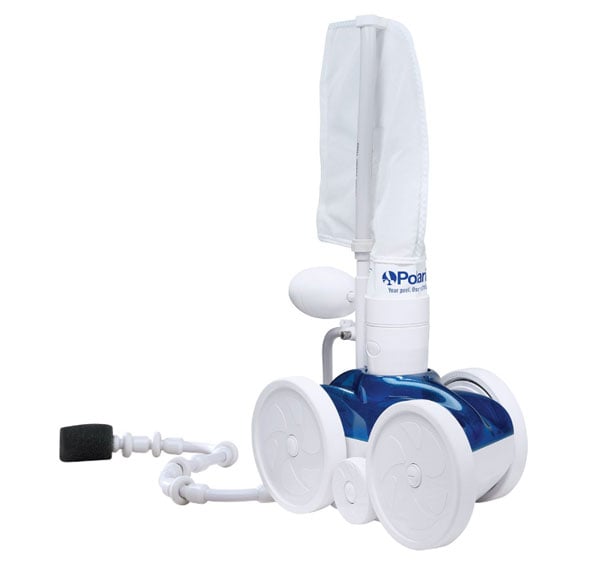
Pressure side pool cleaners like the popular Polaris 280 (shown above) run off of your pool pump’s return water line or using their own dedicated pump.
Pressure side cleaners hook up to the return jet and diverts the water into three streams: a thrust jet to propel the cleaner forward, the sweeper tail at the back which loosens debris on the pool floor and walls and the Venturi which creates a vacuum that sucks up leaves and debris into the filter bag.
A pressure side cleaner is great at picking up medium and large debris like leaves, twigs, and bugs.
Most come with an oversized filter bag that can be replaced with different mesh sizes depending on the type of debris that litters your pool most.
A pressure-side pool cleaner lightens the load on your pool filter and can help extend its life. The pool filter only has to deal with the finer debris that the sweeper tail stirs up.
There are two types of pressure side pool cleaners: those that require a booster pump and those that can run off your existing pool pump.
A booster pump supplements the pressure from your pool pump, allowing the cleaner to move and clean more efficiently. This is helpful for large in-ground pools.
If you buy a pressure side cleaner with a booster pump, we recommend having a professional pool installer do the work for you. Some manufacturers require professional installation in their warranty.
If you decide to go with a non-boosted model, make sure your pool pump meets the minimum size requirements (most cleaners require at least a 3/4 HP pump).
Pressure side pool cleaners are generally more expensive than suction side cleaners with prices ranging between $200 and $900.
How to Install a Pressure Side Pool Cleaner
It’s easy to install a pressure side pool cleaner yourself. The only time you need professional help is if you need to install a booster pump.
After the pump is installed, you can do the rest yourself.
Installation for a pressure side cleaner is pretty much the same as that of suction cleaner. The main difference is that you are hooking it up to the opposite end of the circulation.
Before you start, make sure you have a dedicated return line that is compatible with the size of the fittings that come with the automatic cleaner.
Note: Always read the user manual for specific instructions that apply to your automatic cleaner.
- Clean the pool filter as well as the pump filter basket. You don’t have to clean the pool itself beforehand. As we mentioned, pressure side pool cleaners are good at picking the medium size and large debris.
- Flush the return line by turning on the pool pump for about 5 minutes and then turning it off again.
- Attach the universal wall fitting that came with the cleaner onto your pool’s return line. Depending on the cleaner’s design, you may have to attach a restrictor disk before the universal wall fitting. Check the manual to be sure.
- Attach the quick disconnect to the wall fitting.
- Trim the leader hose to the same length as the deepest part of your pool and then attach it to the quick disconnect wall fitting.
- Connect the leader hose to the feed hose. Extend the hose to the farthest corner of the pool, making sure the hose is within 6” of this point (either longer or shorter). If it’s not the right length, see your manual for advice on how to extend it or trim it.
- Adjust the hose floats as directed in the manual. Most pressure side cleaners require the floats to be evenly spaced. Proper placement of the floats ensures the cleaner can move freely within the pool.
- Assemble the automatic cleaner. This includes attaching the filter bag and any other components that are not yet attached.
- Turn on your main pool pump and let it prime. Then turn on the booster pump if there’s one.
- Measure rotations per minute of the cleaner wheels to make sure they are in the right range. A high RPM will cause the cleaner to float, and it won’t clean the pool properly. Low RPM will reduce mobility. To measure RPM, make a mark on one wheel. Then submerge the cleaner in the pool and count the number of revolutions the wheel makes in one minute (set a 1-min timer on your phone).
- Ensure the RPM are within the range recommended in the manual. If they are not, check your manual for advice on how to adjust RPM.
Once you achieve the right RPM range, let the cleaner do its job. Observe it for a few minutes to make sure it is moving properly.
You may need to adjust the motion of the sweeper tail or the angle of the thrust jet to improve mobility and cleaning. Check your manual for instructions on how to do this.
Maintaining a Pressure Side Pool Cleaner
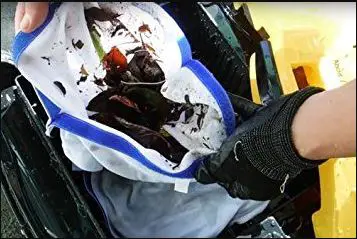
The most important part of maintaining a pressure side automatic pool cleaner is emptying and cleaning the filter bag.
Empty it when it becomes half full.
It can be difficult to dump out the debris when the filter bag is wet. It helps to leave it to dry in the sun, then empty the dirt inside.
Spray the bag with a hose to clean out any remaining particles.
- Tip: Have two filter bags to alternate between.
It’s also important to clean the in-line screen filter. Check your manual on how to remove and clean it.
Regularly check the sweeper hose and any other openings on the cleaner for debris.
For long-term storage in winter, remove the cleaner from the water and drain it of all water. Detach the filter bag.
Leave the cleaner and the bag outside to dry then store them and any other components inside away from direct sunlight.
Pros and Cons of Pressure Side Pool Cleaners
Pros
- They help distribute filtered water throughout the pool.
- Though some pressure side cleaners are just as expensive as robotic pool cleaners, there are also plenty of affordable ones.
- Easy to install and maintain.
- They come with their filter bag, reducing the load on the pool filter and extending its life.
- Using the sweeper brush, they remove algae, and debris stuck on the pool wall and floor.
Cons
- Generally more expensive than suction side cleaners.
- Most struggle to collect fine debris from the pool, leaving it to the pool filter.
Robotic Pool Cleaners
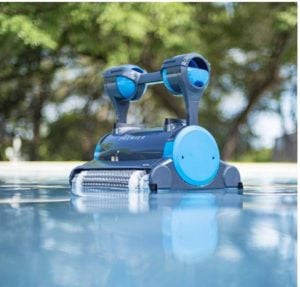
Robotic pool cleaners are self-contained automatic pool cleaners. They do not depend on the pool’s filter or pump.
They work independently of the pool’s circulation, using an electric motor to power wheels or treads as well as an onboard pump that vacuums water through a filter bag or cartridge.
Most pool cleaners also have scrubbing brushes – some as many as four – to remove dirt and algae stuck on the pool floor and walls.
Most in-ground robotic pool cleaners provide almost 100% coverage, cleaning the floor, walls, and waterline.
Above ground cleaners usually scrub and vacuum the floor only and are gentler on the pool’s surface.
Some pool robots clean in a random pattern while others have scanning software to map the pool’s size and layout and calculate the best pattern.
Robotic pool cleaners are the most advanced automatic pool cleaners. They are also the most expensive, although today some models cost about the same as a high-end pressure side pool cleaner.
Prices generally range between $400 and $1,500. Above ground robotic pool cleaners are generally cheaper; rarely costing more than $600.
Robotic pool cleaners for large in-ground pools start at around $700 and can reach nearly $2,000 with options.
How to Install a Robotic Pool Cleaner
Robotic pool cleaners don’t require installation. Since they don’t depend on the pool pump, you don’t need to connect hoses or fittings.
There are two main components to a robotic pool cleaner: the robotic cleaning unit that goes underwater and the power unit that stays on dry land.
The power unit should be located close to a GFCI outlet. This is a type of power outlet that includes a circuit breaker to prevent accidental shock.
Make sure the power unit is shielded from direct sunlight and rain, too. If you have a caddy, place the power unit on it.
How to set up and use your robotic pool cleaner for the first time:
- Assemble the robotic cleaner. You may need to insert the filter basket/bag and a few other components.
- Connect the power cable from the power unit to the pool cleaner. Only let out the amount of cable you need to reduce tangling. But this is not an issue with most robotic cleaners nowadays since they have a swivel that keeps the cable from twisting.
- Plug the power unit into the GFCI outlet.
- Gently submerge the robotic cleaner into the pool and let it sink.
- Go to the control panel and configure cleaning settings. With some models, you can select cleaning time (1hr, 2hrs and so on) and a cleaning program (floor only, floor and walls and so on). Then press the START/ON button.
- If your model has Bluetooth connectivity, you can link it to your phone and configure settings from an app.
- The robot will start cleaning, moving randomly or in a specific pattern. Stick around during the first cleaning in case the cleaner gets stuck somewhere or the cable gets twisted.
- If your pool is very dirty, you may need to empty the debris bag or basket halfway through. Some models come with a ‘filter full’ indicator on the power unit.
- When the cleaner finishes cleaning, gently pull it upwards using the cable. When it is within reach, grab it and lift it out (do not pull it out using the cable). The water will drain as you lift it.
- Empty the collected debris and wash the bag or basket.
- Store the power unit and cleaner in a cool, dry place away from direct sunlight. Some cleaners can be safely left in the pool when not in use (remove when swimming or adding chemicals).
Most robotic pool cleaners come with a weekly scheduler that allows you to set the robot to clean the pool on specific days.
You’ll have to leave the robot in the pool for this to work.
Maintaining a Robotic Pool Cleaner
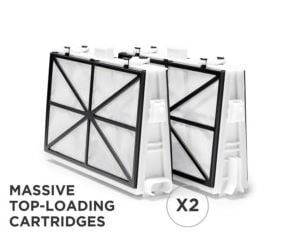
Like pressure-side cleaners, robotic pool cleaners require you to empty and clean the filter bag or cartridge after every cleaning.
It’s also a good idea to check for any debris trapped in the wheels or brushes after each cleaning.
You’ll also need to replace certain components like brushes as they wear out. Not expensive and not frequent, though. Check the manual for the recommended replacement frequency.
For winter storage, clean the filter bag/basket and store everything, including the power unit, inside away from direct sunlight. Roll up the cable and store it inside as well.
Pros and Cons of Robotic Pool Cleaners
Pros
- No installation required – simple plug and play.
- They consume less electricity than other types of automative pool cleaners.
- Most do a great job scrubbing and vacuuming the pool.
- They do not burden your pool pump and filter.
- They help with water mixing, which makes for a healthier pool and reduces how often you need to run the pump.
- They can collect both large and fine debris. Some have two filters for better filtration while in others you can swap between different filters depending on what kind of debris you want it to capture.
- Easy to maintain.
Cons
- Replacement parts such as motors can be expensive to replace. Make sure you get a cleaner with a long, non-prorated warranty.
- Expensive to purchase.
- Require an outdoor GFCI power outlet.
Which Automatic Pool Cleaner Should You Buy?

It depends on your pool cleaning needs and personal preferences.
Buy a suction side pool cleaner if you want a cheap automatic pool cleaner to complement your occasional manual cleaning.
Buy a pressure side pool cleaner if you want an affordable automatic pool cleaner that will remove leaves and other debris from the pool.
Buy a robotic pool cleaner if you want a powerful automatic pool cleaner that will deep clean your pool without relying on the pool pump or filter. Check out our best robotic pool cleaners buying guide to find the best in-ground or above ground robotic pool cleaner for your needs and budget.





